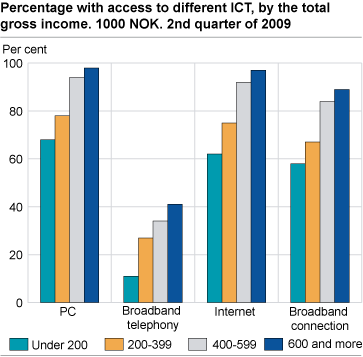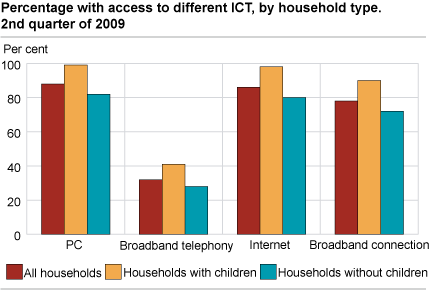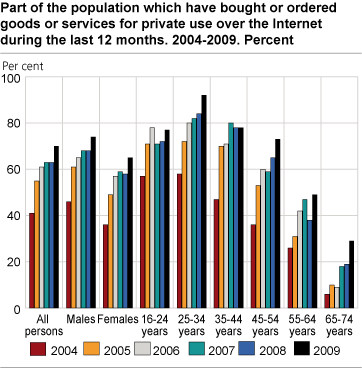Content
Published:
This is an archived release.
Broadband via cable-TV and fibre increases
Eighty-six per cent of households have access to the Internet and 78 per cent have a broadband connection. Broadband via cable-TV and fibre cable have become more important. The number of households with only mobile broadband access has tripled to 60 000 within the last year.
ADSL and other xDSL technologies are the most common Internet connection in Norway. Fifty-eight per cent have xDSL; down from 61 per cent in 2008. The largest increase of 9 percentage points is found in connections by cable-TV and fibre to the home, FTTH; up from 17 to 26 per cent of all households.
Mobile broadband connections have had a breakthrough during the last year. As many as 12 per cent of the population aged 16-74 have a mobile broadband connection. Only 3 per cent have this as their only broadband connection. This amounts to 60 000 households, 50 000 of which are households without children.
Eight per cent of all households have an Internet narrowband connection only. Twenty-five per cent have a mobile narrowband connection, less than 1 per cent of households have this as single access technology.
Generally, families with children and families with high incomes have access to information and communication technology (ICT) more often than others. Younger people and people with higher education also have access to ICT more often than others. A total of 89 per cent of the households with a gross income above NOK 600 000 have broadband. The corresponding figure for households with income below NOK 200 000 is 58 per cent.
Full broadband coverage
Forty-one per cent of those with only narrowband access to the Internet refer to lack of need as the main reason for not having a broadband connection. Fifteen per cent refer to no broadband access available in the area. This confirms that broadband access is getting almost full coverage this year.
Continued growth in the Internet use
Ninety-one per cent of the population have used the Internet during the last three months; an increase from 89 per cent in the previous year. More men and more people with higher education use the Internet every day.
New growth in Internet trade
The part of the population that has bought or ordered goods or services for private use over the Internet during the last 12 months has increased to 70 per cent compared with 63 per cent the previous year. There are only insignificant changes in the share of users for the different goods or services.
One out of ten Internet shoppers has experienced problems connected to this activity. Half of these have encountered technical problems with the website. Less than 2 per cent of all Internet shoppers have reported problems like delayed delivery, wrong or damaged goods delivered or attempted fraud.
About 70 per cent of all Internet shoppers refer to arguments indicating that this makes shopping easy and safe. Around 50 per cent refer to lower prices and larger choice of goods or services. Half of those who didn’t shop via the Internet prefer to shop in person. One out of three has no need to shop on the Internet. Three different arguments regarding safety concerns and lack of trust are referred to by 20 per cent each. There is a tendency that younger persons are less concerned about safety issues than the older age groups.
Eighty-six per cent of Norwegian Internet traders have bought from national suppliers, 37 per cent from EU countries and 20 per cent from the rest of the world.
Large differences in gambling over the Internet
Eleven per cent of Internet users in the last 12 months have placed a bet, gambled or played lotto over the Internet during the same period. This share varies between different parts of the population; 19 per cent of the men and 3 per cent of the women; 21 per cent of the age group 25-34 years and 4 per cent of the age group 65-74 years. The highest share of 27 per cent is found among the unemployed.
|
Many other European countries produce statistics on ICT usage in households in cooperation with the EU’s statistics office Eurostat. The plan for this survey is adapted to Eurostat guidelines. Internationally comparable figures can be found here: http://epp.eurostat.ec.europa.eu/portal/page/portal/information_society/introduction . |
For more information about the survey, please refer to About the statistics.
Tables:
- Table 1 Percentage with access to different ICT, by household type and household income. 2nd quarter of 2009 (Corrected 24 September 2009 at 12:55 p.m.)
- Table 2 Percentage with different kinds of Internet subscriptions, by household type, household income, sex, age, education and employment situation. 2nd quarter of 2009 (Corrected 24 September 2009 at 12:55 p.m.)
- Table 3 Use of computers the last 3 months, by sex, age, education and employment situation. 2nd quarter of 2009. Per cent
- Table 4 Use of the Internet, frequency and location of use last 3 months. Percentage of population, by sex, age, education and employment situation. 2nd quarter 2009
- Table 5 Purpose and nature of activities on the Internet the last 3 months. Percentage of Internet users the last 3 months, by sex, age, education and employment situation. 2nd quarter of 2009
- Table 6 Percentage of Internet users using e-Government, by sex, age, education and employment situation. 2nd quarter of 2009
- Table 7 Types of goods and services bought or ordered over the Internet for private use, the last 12 months, by sex and age. 2nd quarter of 2009. Per cent
- Table 8 Types of problems experienced from private e-commerce in the last 12 months, by sex and age. 2nd quarter of 2009. Per cent
- Table 9 Very important arguments for private e-commerce in the last 12 months, by sex and age. 2nd quarter of 2009. Per cent
- Table 10 Reasons for not doing e-commerce in the last 12 months, by sex and age. 2nd quarter of 2009. Per cent
Contact
-
Bruk av IKT i husholdningene
E-mail: ikthus@ssb.no



